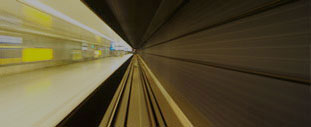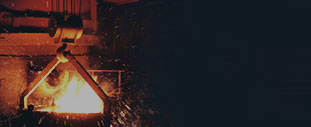

oncrete offers great fire resistance to structures. It is reasonably physically stable to about 550°C, and even above that temperature it usually does not fail dramatically. Concrete's thermal properties protect reinforcing steel and pre-stressing steel, and it does not fall off structural steel members like some fire protection materials can do.
Concrete cannot be set on fire like other materials. As a non-combustible material, it does not emit toxic fumes, produce smoke, or drip molten particles when exposed to fire, unlike plastics or metals. Also, concrete does not add to the fire load in a building. For these reasons, concrete is readily accepted in the majority of building codes as having a high degree of fire resistance. In many applications concrete is virtually fire proof. Concrete’s excellent performance in fire is due to its main constituent materials — cement, water, and aggregates — which, when combined, form a material that is non-combustible and has a thermal conductivity equal to approximately 1/21 that of steel. It is this slow rate of heat transfer that enables concrete to act as an effective fire shield, not only between adjacent spaces but also in protecting reinforcing bars and internal concrete from damage.
The nature of concrete-based structures means that they generally perform very well in fire. However, concrete is a complex material and its properties can change dramatically when exposed to high temperatures. In designing concrete structures under high temperature environments, information about fundamental properties, e.g. strength, stiffness and toughness at high temperatures, is often required. Fracture energy is an important toughness parameter for the numerical simulation of concrete structures under varied loading and environmental conditions, and assessment of fire safety.
All of this does not mean that concrete is not adversely affected by fire or heat. Most of the products of Portland cement hydration are to a large degree physically stable (some shrinkage does occur) to the 500°C level, but some are not. Ettringite, a normal minor component of concrete, can decompose below the boiling point of water (100°C) but usually without deleterious effects because it is present in only small amounts, and the water evolved lowers temperatures within the concrete.
Like all road constructions, tunnels are prone to accidents that include fire, a particular problem being leaking oil from vehicles. This can cause a rise in temperature of about 1000 ºC in only a few minutes, which may last for several hours. Obviously, this will have a detrimental effect on the tunnel construction, but exactly how detrimental is difficult to determine.
The need for protecting concrete against the ravages of fire has been understood for many years, with fire safety engineering for tunnels in particular taking hold primarily in the Netherlands from 1978 following a major fire within the Vesler immersed tube tunnel. Some time in 1979 the Rijkswaterstaat (an executive agency of the Dutch Ministry of Transportation and Water Management) published its Rijkswaterstaat (RWS) time temperature curve. At the time the first step to a realisation that fire in tunnels were not the same as fires within buildings. The RWS curve was based on engineering assumptions and described the temperature-time relationship of a fire in a tunnel with petrol leaking out of a tanker. Its accompanying design method was based on insulating concrete to increase the time it took for concrete to reach temperatures above 380 ºC by applying fire protective materials.
Concrete exposed to up to 100°C is normally considered as healthy. The parts of a concrete structure that is exposed to temperatures above approximately 300°C (dependent of water/cement ratio) will most likely get a pink colour. Over approximately 600°C the concrete will turn light grey, and over approximately 1000°C it turns yellow-brown. One rule of thumb is to consider all pink coloured concrete as damaged, and to be removed.
After a fire, structural damage is usually assessed primarily by visual observation e.g. look for spalling of the concrete structure. As described above, concrete exposed to temperatures of roughly 300ºC and higher will turn pink, and since this roughly corresponds to the onset of the main strength loss, the rule of thumb is to look for any pink concrete, remove this by force, and replace it with new concrete (shotcrete). Although in principle valid, this practice ignores the structural damage that may have been done to the rest of the tunnel.
During a tunnel fire, air temperatures can rise to over 1300°C within just a few minutes. Compared to building fires, this is a much more severe situation, giving a large thermal shock to the structure. For the design of buildings, there is worldwide agreement on the use of the ISO-834 “standard” fire, which prescribes a slower temperature development. For tunnels many design curves are available. Although usually a less expensive solution is obtained by using a lower fire curve, this may well lead to unsafe situations.
Recent full scale tunnel fire tests carried out by the UPTUN consortium in Europe, for example, have shown that fire temperatures may quickly reach 1300°C to 1400°C. This is a critical issue because many insulation materials cannot withstand temperatures above 1200°C or may be unable to withstand the thermal shock of such a rapidly developing fire, and may therefore be unsuitable for protection of a tunnel lining. During heating, stresses develop inside the concrete cross-section. Thermal gradients and moisture pressure lead to mechanical stresses that may cause internal and external cracking as well as spalling of concrete.
Spalling of concrete is one cause of damage to the structure. Other causes of damage that develop during fire exposure are internal cracking, irreversible plastic and creep strains and chemical transitions. These forms of damage might eventually lead to collapse due to a failure mechanism like bending, shear, anchorage or buckling. Often when concrete is damaged in a real fire the damage is called spalling. In many cases this is not correct; other failure mechanisms such as shear failure can also lead to severely damaged concrete.








